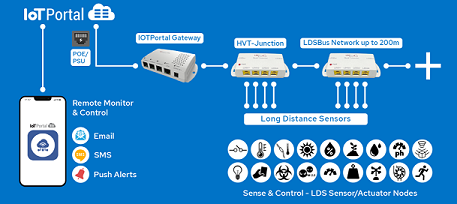Unifying Building Control Systems Under One Platform
Building management systems today use many self-contained subsystems and control interfaces, such as lighting, temperature and access control systems. Whilst these bring many benefits to controlling the operation of the building, if these systems are not integrated the estate manager cannot leverage their full benefits. Several challenges include systems requiring their own user interfaces, control protocols and separate cabling systems. Often these operate in isolation from other systems within the building. The introduction of smart building solutions aims to rectify these issues.
Smart Buildings benefit organisations by minimising and standardising the control interfaces required to operate the building, thus allowing for better staff utilisation throughout the company. Centralizing multiple building systems into one Smart Building Dashboard can reduce training and maintenance costs allowing for easier monitoring by the estate or building manager. Smart Building techniques can also significantly reduce the energy usage of an organisation and improve occupants’ comfort levels by automating the lighting and HVAC systems within a building or estate.
The IoTPortal provides these benefits to an organisation by unifying building control systems under one platform enabling convenience, safety, energy efficiency and cost savings. The main components of the IoT Portal are the IoT Gateway, the Long Distance Sensor (LDSBus) and its cloud based monitoring dashboard and control service.

The system is centred around the IoTPortal Gateway which provides hosting and management of the LDSBus which links to the systems sensors and actuators, whilst forming a connection to the cloud service. The system allows for graphical real time monitoring of connected gateways and their associated sensor data and actuators’ status. The use of cloud services provides centralised data storage and allows multiple gateways to appear as one network. The estate administrator can view the data from multiple buildings simultaneously via the cloud from the control dashboard, from a central monitor and remotely via iOS or Android applications.
A gateway provides three LDSBus ports, the daisy chained architecture and common communication protocol makes it easy to install and extend the system via HVT-Junctions. The HVT-Junctions connect applicable sensors and actuators to the main LDSBus. The functionality of the cloud system provides data processing and allows the system to react to sensor inputs with pre-defined actuator outputs.

The LDSBus and accompanying HVT-Junctions can support up to 320 sensors or actuators from a single Gateway. A wide range of sensors are available including our 4-in-1 sensor which can monitor ambient temperature, brightness, humidity and incorporates motion detection. Similarly, a wide range of actuators are available such as the LDSBus Isolated IO Controller, LDSBus Trailing Edge Dimmer and the LDSBus 2-CH (channel) Relay actuators. The fully integrated nature of the IoT Portal allows the output from these sensors to be processed in the cloud and a determination of the most appropriate actuator output in response based upon system settings. For example, if the system detects a change in ambient air temperature it may determine that the HVAC settings require adjustment via the IO Controller. Alternatively, if the measured light falls below the pre-defined level the system can react by increasing brightness of the internal lighting via the lighting dimmer or opening window blinds via a relay actuator. In addition to the individual benefits within one building, the integration of multiple gateways through the cloud into one system allows an administrator to monitor the status of an entire estate or a head office to monitor different offices around the world.
The IoT Portal helps companies take advantage of smart building techniques within their organisation. Some of the benefits include:
• Cloud-based system allows integration between different buildings and estates for centralised and remote monitoring
• A single unified system enables integration between all sensors and actuators allowing for optimal energy and cost savings
• Reduced installation and maintenance costs due to common protocols and system cabling
• User-friendly dashboard reduces training cost via the centralised control platform and an improved user experience
Visit Bridgetek for more info
